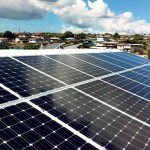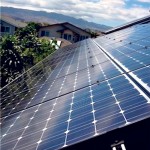Hot Topics in PV Energy
Since it is the final stage of the fourth quarter of the year, activity in the solar energy market is literally “heating up.” Permits from the City and County Building Department are at an all-time high. Also on the horizon are governmental actions with far-reaching effects for consumers.
It is widely believed that the Hawaii State Legislature may be contemplating revisions to the tax code, which will restrict and/or reduce energy tax credits in an effort to combat the state’s budgetary shortfall on tax revenues. A reduction from 35 to 25 percent is rumored to be in the works. Some believe that any such action in the 2013 session will take effect in 2014.
According to a recent news article, the Hawaii State Tax Department unilaterally implemented limits to the tax credits that homeowners can claim starting in the 2013 tax year. While legislative action is necessary to reduce the percentage or dollar amount of the allowable credits, the department has limited the number of photovoltaic (PV) systems that may be claimed per qualified residence per tax year. The department has placed a limit of one PV system with a cap of $5,000. At this point, there is little time left for consumers to take advantage of the nation’s most generous tax credit program.
Consumers contemplating PV systems in 2013 and beyond would be wise to consider this: even without tax incentives, PV electrical systems are still attractive from a financial perspective. A $30,000 system that saves $200 per month equals an 8 percent annual rate of return ($2,400 savings divided by a $30,000 cost equals 8 percent). The less competitively priced designs still return at least 5 percent annually — have you checked the rates on money-market funds or treasury bills lately? The more efficient and aggressively priced systems can return nearly 10 percent.
The fact remains that even at reduced incentives, returns are extremely high. With a current federal credit of 30 percent ($9,000) and a $5,000 state cap, the return on the above example is $2,400 divided by $16,000, which equals 15 percent. There is nothing shabby about that kind of result.
Consumers who undertake action as quickly as possible benefit by saving on their utility costs sooner rather than later. After all, every dollar paid to the power company is money that will never be recovered.
But don’t deceive yourself. Hasty action has the effect of not doing one’s “due diligence” in making the wisest choice in contractors available. In the end, the “wrong” choice could cost the consumer thousands.
Is it time for consumers to “pull the trigger” and “go green?” Emphatically, yes! If the homeowner is financially able, “beating the clock” for higher tax credits after doing one’s “due diligence” makes a lot of sense.
There is one caveat: Based on increased advertising on television, radio and print media, it seems that many current solar companies are new players that were not in the business a year ago. A good number of them are likely marketing organizations that subcontract their installations. The full-service contractors seem to be a dwindling breed.
Hi-Power Solar is one such “full-service” contractor, offering sales and service for solar water heaters as well as PV energy. Principals Ron Romero, who has more than 20 years of experience in the solar business, and Matt Adams, who has more than 16 years of experience, offer an excellent balance of top-notch components, expert installation and competitive pricing. They are familiar with City and County building codes and adhere to special homeowner association rules.
Joining the solar revolution is likely to provide a financial bonanza for the consumer. It pays to be a little cautious in choosing the most appropriate system design and to explore the financial costs, which impact your pocketbook.
HI-POWER SOLAR
contact // 342-0802
web // www.hi-powersolar.com

